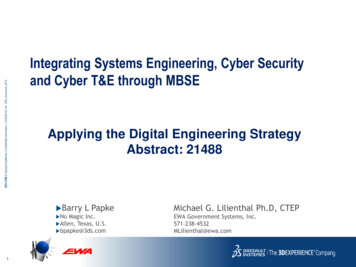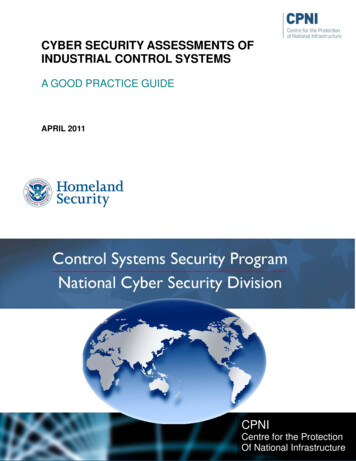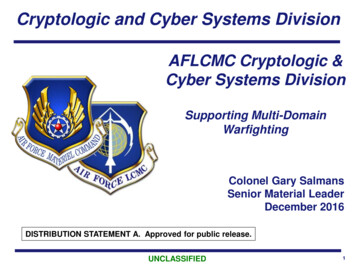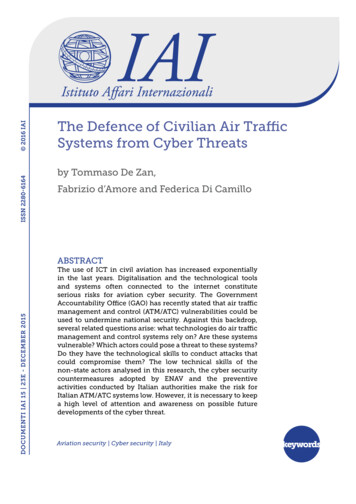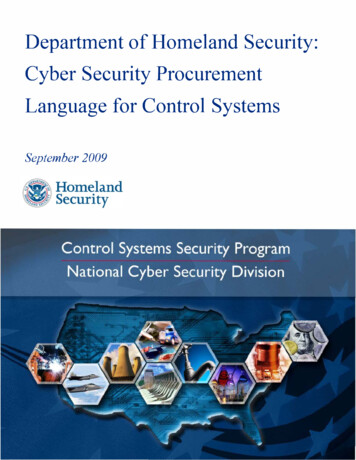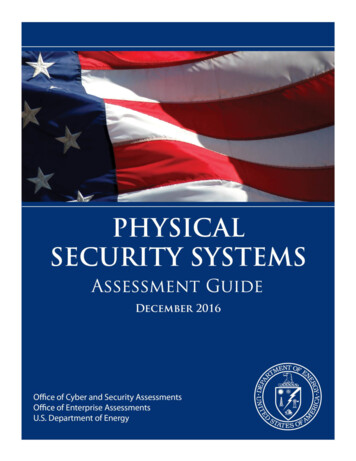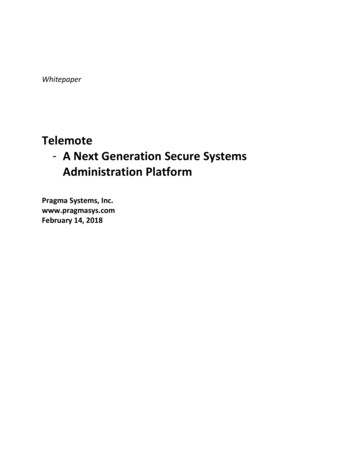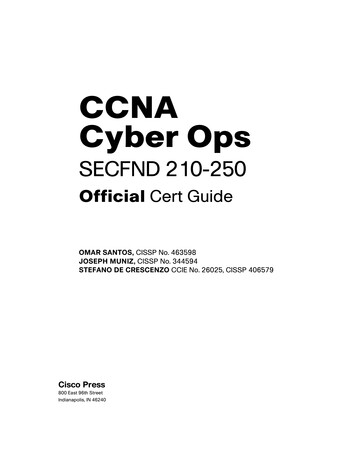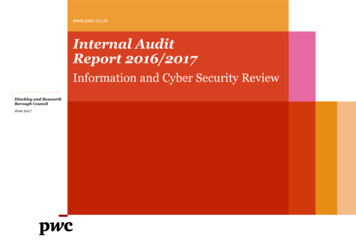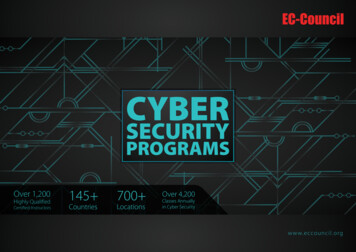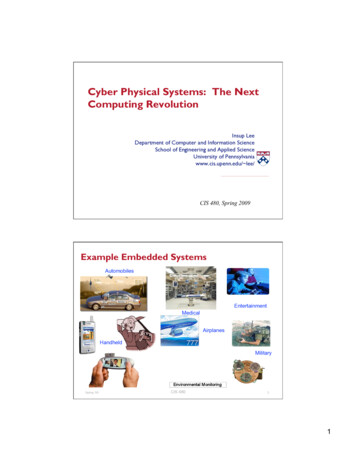
Transcription
Cyber Physical Systems: The NextComputing RevolutionInsup LeeDepartment of Computer and Information ScienceSchool of Engineering and Applied ScienceUniversity of Pennsylvaniawww.cis.upenn.edu/ lee/CIS 480, Spring 2009Example Embedded dheldMilitarySpring ‘09CIS 48021
The Next Computing Revolution Mainframe computing (60’s-70’s)o Large computers to execute big data processing applications Desktop computing & Internet (80’s-90’s)o One computer at every desk to do business/personal activities Ubiquitous computing (00’s)o Numerous computing devices in every place/persono “Invisible” part of the environmento Millions for desktops vs. billions for embedded processors Cyber Physical Systems (10’s)CIS 480Spring ‘093Cyber-Physical Systems:Trend 1: Proliferation (By Moore’s o, machineryfactory floor, “Sensor Networks” Unattended multihopad hoc wirelessMedicalSmart Spaces,Assisted Living[TA]2
Cyber-Physical Systems:Trend 2: Integration at Scale (Isolation has cost!) Low end: ubiquitous embedded devicesHigh end: complexsystems with globalintegration Large-scale networked embedded systemsSeamless integration with a physical environment Picture courtesy ofPatrick LardieriTotal Ship Computing Environment(TSCE)World Wide Sensor Web(Feng Zhao)Integrationand ScalingChallengesLow EndExamples: Global InformationGrid, Total Ship ComputingEnvironmentGlobal Information GridFuture Combat System(Rob Gold)High End [TA]Cyber-Physical Systems:Trend #3: Biological Evolution[TA]3
Cyber-Physical Systems:Trend #3: Biological Evolution It’s too slow!o The exponential proliferation of embedded devices (afforded by Moore’s Law)is not matched by a corresponding increase in human ability to consumeinformation! Increasing autonomy (human out of the loop), direct world access[TA]Confluence of TrendsThe Overarching ChallengeTrend2: Integration at Scale(Isolation has cost)Trend1: Device/Data Proliferation(by Moore’s Law)Trend3: Autonomy(Humans are not getting faster)[TA]4
Confluence of TrendsThe Overarching ChallengeTrend2: Integration at Scale(Isolation has cost)Distributed Cyber-PhysicalInformation Distillation and ControlTrend1: Device/Data Proliferation Systems (of Embedded Devices)(by Moore’s Law)Trend3: Autonomy(Humans are not getting faster) [TA]Confluence of TrendsThe Overarching ChallengeTrend2: Integration at Scale(Isolation has cost)Scale challenges Composition challengesDistributed Cyber-PhysicalInformation Distillation and ControlTrend1: Device/Data Proliferation Systems (of Embedded Devices)(by Moore’s Law)Trend3: Autonomy(Humans are not getting faster) [TA]5
What are Cyber Physical Systems? Cyber-physical systems (CPSs) arephysical and engineered systems whoseoperations are monitored, coordinated,controlled and integrated by acomputing and communication core. A cyber-physical system integratescomputing, communication, andstorage capabilities with the monitoringand/or control of entities in the physicalworldo from the nano-world to large-scalewide-area systems of systemso dependably, safely, securely, efficientlyand in sControl Wirelesssensornetworks Convergence of computation,communication, and controlCIS 480Spring ‘0911Characteristics of CPS Some defining characteristics:o Cyber – physical coupling driven by new demands and applications Cyber capability in every physical component Large scale wired and wireless networking Networked at multiple and extreme scaleso Systems of systems New spatial-temporal constraintsComplex at multiple temporal and spatial scalesDynamically reorganizing/reconfiguringUnconventional computational and physical substrates (Bio? Nano?)o Novel interactions between communications/computing/control High degrees of automation, control loops must close at all scales Large numbers of non-technical savvy users in the control loop o Ubiquity drives unprecedented security and privacy needso Operation must be dependable, certified in some casesTipping points/phase transitionso Not desktop computing, Not traditional, post-hoc embedded/real-time systems, Nottoday’s sensor netso Internet as we know now, stampede in a moving crowd, Spring ‘09CIS 480126
Example: Automotive Telematics In 2005, 30-90 processors per caro Engine control, Break system, Airbag deployment systemo Windshield wiper, door locks, entertainment systemso Example: BMW 745i 2,000,000 LOC Window CE OS Over 60 microprocessors 53 8-bit, 11 32-bit, 7 16-bit Multiple networks Buggy? Cars are sensors and actuators in V2V networksoooActive networked safety alertsAutonomous navigation Spring ‘09CIS 48013Example: Health Care and Medicine National Health Information Network, Electronic PatientRecord initiativeo Medical records at any point of serviceo Hospital, OR, ICU, , EMT? Home care: monitoring and controlo Pulse oximeters (oxygen saturation), blood glucose monitors,infusion pumps (insulin), accelerometers (falling, immobility),wearable networks (gait analysis), Operating Room of the Futureo Closed loop monitoring and control; multiple treatmentstations, plug and play devices; robotic microsurgery(remotely guided?)o System coordination challenge Progress in bioinformatics: gene, protein expression;systems biology; disease dynamics, control mechanismsSpring ‘09CIS 48014Images thanks to Dr. Julian Goldman, Dr. Fred Pearce7
Example: Electric Power Grid Current picture:o Equipment protection devices trip locally,reactivelyo Cascading failure: August (US/Canada) andOctober (Europe), 2003 Better future?o Real-time cooperative control of protectiondeviceso Or -- self-healing -- (re-)aggregate islands ofstable bulk power (protection, market motives)o Ubiquitous green technologieso Issue: standard operational control concernsexhibit wide-area characteristics (bulk powerstability and quality, flow control, fault isolation)o Technology vectors: FACTS, PMUso Context: market (timing?) behavior, powerrouting transactions, regulationCIS 480Spring ‘09IT Layer15Images thanks to William H. Sanders, Bruce Krogh, and Marija IlicApplication Domains of Cyber-Physical Systems Healthcareo Medical deviceso Health management networksHealthcare TransportationoooooAutomotive electronicsVehicular networks and smart highwaysAviation and airspace managementAvionicsRailroad systems Process control Large-scale InfrastructureTransportationCPSFinance o Physical infrastructure monitoring and controlo Electricity generation and distributiono Building and environmental controls Defense systems Tele-physical operationso Telemedicineo Tele-manipulationIn general, any “X by wire(less)” where X is anythingCIS 480 in nature.16that is physicalSpring ‘098
Grand Visions and Societal Impact Near-zero automotive traffic fatalities, injuries minimized, andsignificantly reduced traffic congestion and delays Blackout-free electricity generation and distribution Perpetual life assistants for busy, older or disabled people Extreme-yield agriculture Energy-aware buildings Location-independent access to world-class medicine Physical critical infrastructure that calls for preventive maintenance Self-correcting and self-certifying cyber-physical systems for “one-off”applications Reduce testing and integration time and costs of complex CPS systems(e.g. avionics) by one to two orders of magnitudeCIS 480Spring ‘0917Key Trends in Systems System complexityooooIncreasing functionalityIncreasing integration and networking interoperabilityGrowing importance and reliance on softwareIncreasing number of non-functional constraints Nature of tomorrow’s systemso Dynamic, ever-changing, dependable, high-confidenceo Self-*(aware, adapting, repairing, sustaining) Cyber-Physical Systems everywhere, used by everyone, for everythingo Expectations: 24/7 availability, 100% reliability, 100% connectivity, instantaneousresponse, remember everything forever, o Classes: young to old, able and disabled, rich and poor, literate and illiterate, o Numbers: individuals, special groups, social networks, cultures, populations, Spring ‘09CIS 480189
Societal Challenge How can we providepeople and society withcyber-physical systemsthat they can trust theirlives on? Trustworthy:reliable, secure, privacypreserving, usable, etc.Partial list of complex system failureso Denver baggage handling system( 300M)o Power blackout in NY (2003)o Ariane 5 (1996)o Mars Pathfinder (1997)o Mars Climate Orbiter ( 125M,1999)o The Patriot Missile (1991)o USS Yorktown (1998)o Therac-25 (1985-1988)o London Ambulance System ( 9M,1992)o Pacemakers (500K recalls during1990-2000)o Numerous computer-relatedIncidents wth commer ons/compendium/incidents and accidents/index.html)CIS 480Spring ‘0919R&D Needs Development of high-confidence CPS requireso Engineering design techniques and tools Modeling and analysis, requirements capture, hybrid systems, testing Capture and optimization of inter-dependencies of different requirements Domain-specific model-based toolso Systems Software and Network Supports Virtualization, RTOS, Middleware, Predictable (not best-effort) communication with QoS, predictable delay & jitterbounds, Trusted embedded software components To help structured system design and system development To reduce the cost of overall system development and maintenance efforts To support the reuse of components within product familieso Validation and Certification Metrics for certification/validation Evidence-based certification, Incremental certificationSpring ‘09CIS 4802010
Scientific Challenges Computations and Abstractionsooo Compositionalityooo Composition and interoperation of cyber physical systemsCompositional frameworks for both functional, temporal, and non-functional propertiesRobustness, safety, and security of cyber physical systemsSystems & Network Supportsooo Computational abstractionsNovel Real-time embedded systems abstractions for CPSModel-based development of CPSCPS Architecture, virtualizationWireless and smart sensor networksPredictable real-time and QoS guranattees at multiple scalesNew foundationsooooSpring ‘09Control (distributed, multi-level in space and time) and hybrid systems - cognition of environmentand system state, and closing the loopDealing with uncertainties and adaptability - graceful adaptation to applications, environments, andresource availabilityScalability, reliability, robustness, stability of system of systemsScience of certification - evidence-based certification, measures of verfication, validation, and testingCIS 48021Software, the Great Enabler Good news: anything is possible in software! Bad news: anything is possible in software! It is the software that affects system complexity andalso cost.o Software development stands for 70-80 % of the overalldevelopment cost for some embedded systems.Spring ‘09CIS 4802211
Embedded Software - Goals Trustworthy: should not fail (or at least gracefully degrade), and safe touse. The existence of embedded software becomes apparent only when anembedded system fails. Context- and Situation-Aware: should be able to sense people,environment, and threats and to plan/notify/actuate responses to providereal-time interaction with the dynamically changing physical environmentwith limited resources. Seamless Integration: should be invisible at multiple levels of a hierarchy:home systems, metropolitan systems, regional systems, and nationalsystems. Validation and Certification: should be able to assure that embeddedsystems work correctly with respect to functional and nonfunctionalrequirements with high degree of certainty.Spring ‘09CIS 48023Software Research Challenges Need new notions of “correctness” and “compositionality”o Factor in context of use, unpredictable environment, emergentproperties, dynamism, interoperabilityo What are desired properties of and metrics for both software andsystems (e.g., resource use) Need new formal models and logics for reasoning about CPSo Uncertainty, physical world, mental model of human usero Hybrid automata, probabilistic logic Need new verification/analysis tools usable by domainengineerso Push-button, lightweighto Integrated with rest of system development processSpring ‘09CIS 4802412
Interaction Complexity We know how to design and build components. Systems are about the interactions of components.o Some interactions are unintended and unanticipated Interoperability Emerging behaviors “Normal Accidents”, an influential book by Charles Perrow (1984)o One of the Three Mile Island investigatorso And a member of recent NRC Study “Software for Dependable Systems:Sufficient Evidence?”o A sociologist, not a computer scientist Posits that sufficiently complex systems can produce accidents without asimple cause due too interactive complexity and tight couplingCIS 480Spring ‘0925Potential Accidental Systems Many systems created without conscious design by interconnectingseparately designed components or separate systems.o Unsound composition: the interconnects produce desired behaviors most ofthe timeo Feature interactions: promote unanticipated interactions, which could lead tosystem failures or accidents Modes of interactionsoooooAmong computation componentsThrough share resourcesThrough the controlled plant (e.g., the patient)Through human operatorsThrough the larger Environment E.g., Medical Device PnP could facilitate the construction of accidentalsystemso blood pressure sensor connected to bed height, resulting in the criticalityinversion problemSpring ‘09CIS 4802613
Unexpected interactions Landed on the Martiansurface on July 4th, 1997 Unconventional landing –boucing into the Martiansurface A few days later, not longafter Pathfinder startedgathering meteorologicaldata, the spacecraft beganexperiencing total systemreset, each resultin
A cyber-physical system integrates computing, communication, and storage capabilities with the monitoring and/or control of entities in the physical world o from the nano-world to large-scale wide-area systems of systems o dependably, safely, securely, efficiently and in real-time Convergence of computation, communication, and control Real-Time Embedded Systems Wireless sensor networks .
